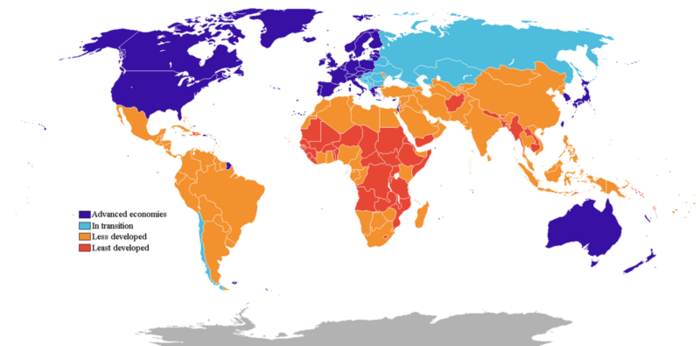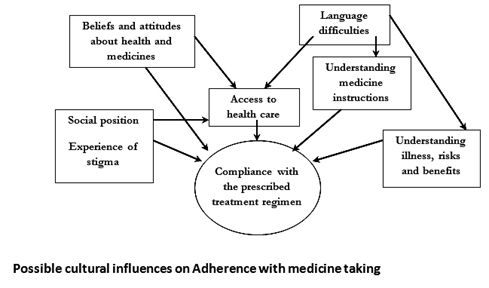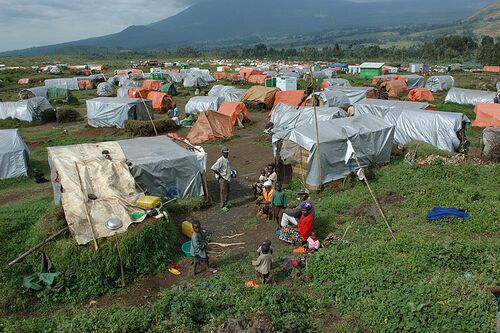The Role of Rehabilitation Within Low Resource Settings: Difference between revisions
(wording) |
m (wording) |
||
| Line 24: | Line 24: | ||
When healthcare services are obtainable, are they affordable? <ref name=":1" /> | When healthcare services are obtainable, are they affordable? <ref name=":1" /> | ||
[[File:Socialdeterminants.jpg|489x489px|alt=|frameless|right]] | |||
* <u>'''Acceptability'''</u> | * <u>'''Acceptability'''</u> | ||
People living within these settings may have educational and cultural differences that may prevent them from pursuing healthcare services and/or they may not appreciate the potential health benefits.<ref name=":1" /> | People living within these settings may have educational and cultural differences that may prevent them from pursuing healthcare services and/or they may not appreciate the potential health benefits.<ref name=":1" /> | ||
=== Rehabilitation Specific === | === Rehabilitation Specific === | ||
Within low resource settings, the needs for rehabilitation services are high, however, there are low resources and low supply (meaning both quantity and quality). These countries have less than ten skilled rehabilitation providers per 1 million population. <ref>Bright T, Wallace S, Kuper H. [https://www.mdpi.com/1660-4601/15/10/2165/htm A systematic review of access to rehabilitation for people with disabilities in low-and middle-income countries]. International journal of environmental research and public health. 2018 Oct;15(10):2165.</ref> The demand for these services continues to increase as the world manages global warming, droughts, floods, natural disasters, war and conflict, epidemics and migration and displacement.<ref name=":2">Barth, C. The Role of Rehabiliation in Low Resource Settings. Course. Physioplus. 2021</ref> <ref>Jesus TS, Landry MD, Hoenig H. [https://www.mdpi.com/1660-4601/16/6/980/htm Global need for physical rehabilitation: systematic analysis from the Global Burden of Disease Study 2017.] International journal of environmental research and public health. 2019 Jan;16(6):980.</ref> | Within low resource settings, the needs for rehabilitation services are high, however, there are low resources and low supply (meaning both quantity and quality). These countries have less than ten skilled rehabilitation providers per 1 million population. <ref>Bright T, Wallace S, Kuper H. [https://www.mdpi.com/1660-4601/15/10/2165/htm A systematic review of access to rehabilitation for people with disabilities in low-and middle-income countries]. International journal of environmental research and public health. 2018 Oct;15(10):2165.</ref> The demand for these services continues to increase as the world manages global warming, droughts, floods, natural disasters, war and conflict, epidemics and migration and displacement.<ref name=":2">Barth, C. The Role of Rehabiliation in Low Resource Settings. Course. Physioplus. 2021</ref> <ref>Jesus TS, Landry MD, Hoenig H. [https://www.mdpi.com/1660-4601/16/6/980/htm Global need for physical rehabilitation: systematic analysis from the Global Burden of Disease Study 2017.] International journal of environmental research and public health. 2019 Jan;16(6):980.</ref> | ||
[[File:Lowincomemigration.jpg|center|thumb|500x500px|Migration in Low Resource Setting]] | |||
=== | === <u>Future Course</u> === | ||
==== Knowledge ==== | |||
Working in low-income settings requires investigating the local political, economical, cultural and social circumstances within that region. High-income country interventions should be adapted to the cultural norms of local settings. Additionally, donations of equipment and medication should bear in mind the needs of the location to which they are being sent.<ref name=":0">Bauer I. More harm than good? [https://tdtmvjournal.biomedcentral.com/articles/10.1186/s40794-017-0048-y The questionable ethics of medical volunteering and international student placements.] Tropical diseases, travel medicine and vaccines. 2017 Dec;3(1):1-2.</ref>Learning about the culture will prevent a misuse of donations as in the real life examples below: | |||
# hip prosthesis provisions distributed to a country where people were used to squatting.<ref name=":0" /> | |||
# dispensing of lice shampoo to illiterate people who view shampoo as a luxury and like to share with others<ref name=":0" /> | |||
==== Advocate ==== | |||
In low resource settings there is minimal recognition of rehabilitation services. This prevents this sector to be on equal footing within the local health systems. Advocating to have rehabilitation services be a division within the Ministries of Health would allow professionals to access education models, health resources and research funding. Advocating for these services should be to health policymakers, local health authorities and to the people living within these areas. <ref name=":2" /> | |||
==== Listen ==== | |||
Utilizing high-income country interventions (even evidence-based research) is not applicable for these settings. Services provided will need to be determined by the people living there and the situation within these diverse settings. Effective strategies for interventions are to start by listening to experts on the ground who can make suggestions on identifying resources that are available within that particular setting.<ref name=":2" /> | Utilizing high-income country interventions (even evidence-based research) is not applicable for these settings. Services provided will need to be determined by the people living there and the situation within these diverse settings. Effective strategies for interventions are to start by listening to experts on the ground who can make suggestions on identifying resources that are available within that particular setting.<ref name=":2" /> | ||
Revision as of 16:42, 3 November 2021
Original Editor - Robin Tacchetti based on the course by Cornelia Barth
Top Contributors - Robin Tacchetti, Robin Leigh Tacchetti, Wanda van Niekerk, Tarina van der Stockt, Kim Jackson, Jess Bell and Stacy Schiurring
Introduction[edit | edit source]
Recent estimates by the World Health Organization state that over 1 billion people in the world need rehabilitation services, 80% being from low and middle-income countries. Poverty breeds disability and disability breeds poverty as they are inherently linked.[1] Compounding poverty in these settings is malnutrition, non-potable water, unsanitary conditions and inadequate shelter.[2] Attaining healthcare services in these poor areas is particularly challenging as many of them are also grappling with political uncertainty, corruption, volatile security, lack of professional healthcare training, dysfunctional and/or overwhelmed health system and insufficient roads to access services.[3]
Health Inequalities in Low Resource Settings[edit | edit source]
Poor people living in low-income settings tend to be the least healthy and benefit the most from healthcare. Social determinants of health such as education, income level, gender, ethnicity, place of residence and employment status have a direct correlation on the rate of illness with lower income-countries bearing a higher burden of disease or illness.[4].
Access to Care[edit | edit source]
Accessibility to healthcare services is a crucial problem. When discussing access to care, one needs to consider if the services are available, affordable and well accepted.[5]
- Availability
If healthcare services are provided within these settings, oftentimes it is found to be of poor quality. Substandard care or non- effective care lends itself to mistrust in healthcare and a decrease in demand for these services. This in turn will hinder beliefs in seeking future care and breed mistrust in providers. [5]
- Affordability
When healthcare services are obtainable, are they affordable? [5]
- Acceptability
People living within these settings may have educational and cultural differences that may prevent them from pursuing healthcare services and/or they may not appreciate the potential health benefits.[5]
Rehabilitation Specific[edit | edit source]
Within low resource settings, the needs for rehabilitation services are high, however, there are low resources and low supply (meaning both quantity and quality). These countries have less than ten skilled rehabilitation providers per 1 million population. [6] The demand for these services continues to increase as the world manages global warming, droughts, floods, natural disasters, war and conflict, epidemics and migration and displacement.[7] [8]
Future Course[edit | edit source]
Knowledge[edit | edit source]
Working in low-income settings requires investigating the local political, economical, cultural and social circumstances within that region. High-income country interventions should be adapted to the cultural norms of local settings. Additionally, donations of equipment and medication should bear in mind the needs of the location to which they are being sent.[9]Learning about the culture will prevent a misuse of donations as in the real life examples below:
- hip prosthesis provisions distributed to a country where people were used to squatting.[9]
- dispensing of lice shampoo to illiterate people who view shampoo as a luxury and like to share with others[9]
Advocate[edit | edit source]
In low resource settings there is minimal recognition of rehabilitation services. This prevents this sector to be on equal footing within the local health systems. Advocating to have rehabilitation services be a division within the Ministries of Health would allow professionals to access education models, health resources and research funding. Advocating for these services should be to health policymakers, local health authorities and to the people living within these areas. [7]
Listen[edit | edit source]
Utilizing high-income country interventions (even evidence-based research) is not applicable for these settings. Services provided will need to be determined by the people living there and the situation within these diverse settings. Effective strategies for interventions are to start by listening to experts on the ground who can make suggestions on identifying resources that are available within that particular setting.[7]
4. Partnerships
Western professionals can assist low resource healthcare professionals via education and professional development. NGOs should move from short-term to long-term partnerships with local authorities to improve health care over time. [9]
5. Fiscal
Money can be utilized in many ways for these low resource settings including the following:
- can focus on prevention
- Improve local services
- Support for patients who cannot pay
- Supplies for hospitals, clinics [9]
Resources[edit | edit source]
- https://www.who.int/initiatives/rehabilitation-2030
- https://www.who.int/disabilities/care/Need-to-scale-up-rehab-July2018.pdf
- Role of Physiotherapists in Global Health
- Global Health
- Determinants of Health
- Rehabilitation Contexts
- Introduction to Rehabilitation
References[edit | edit source]
- ↑ Bright T, Wallace S, Kuper H. A systematic review of access to rehabilitation for people with disabilities in low-and middle-income countries. International journal of environmental research and public health. 2018 Oct;15(10):2165.
- ↑ Orach D, Garimoi C. Health equity: challenges in low income countries. African health sciences. 2009 Oct 1;9(s2):S49-51.
- ↑ Barth CA. Meeting the needs of people with physical disabilities in crisis settings. Bulletin of the World Health Organization. 2019 Dec 1;97(12):790.
- ↑ https://www.who.int/news-room/facts-in-pictures/detail/health-inequities-and-their-causes
- ↑ 5.0 5.1 5.2 5.3 Peters DH, Garg A, Bloom G, Walker DG, Brieger WR, Hafizur Rahman M. Poverty and access to health care in developing countries. Annals of the new York Academy of Sciences. 2008 Jun;1136(1):161-71.
- ↑ Bright T, Wallace S, Kuper H. A systematic review of access to rehabilitation for people with disabilities in low-and middle-income countries. International journal of environmental research and public health. 2018 Oct;15(10):2165.
- ↑ 7.0 7.1 7.2 Barth, C. The Role of Rehabiliation in Low Resource Settings. Course. Physioplus. 2021
- ↑ Jesus TS, Landry MD, Hoenig H. Global need for physical rehabilitation: systematic analysis from the Global Burden of Disease Study 2017. International journal of environmental research and public health. 2019 Jan;16(6):980.
- ↑ 9.0 9.1 9.2 9.3 9.4 Bauer I. More harm than good? The questionable ethics of medical volunteering and international student placements. Tropical diseases, travel medicine and vaccines. 2017 Dec;3(1):1-2.









